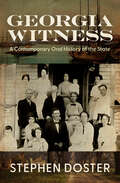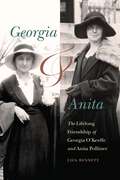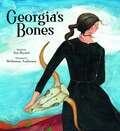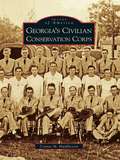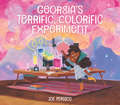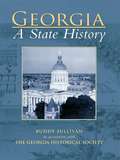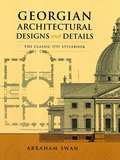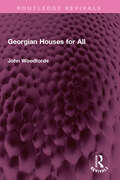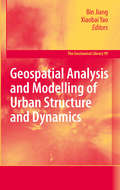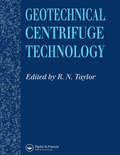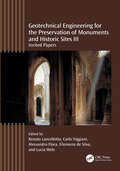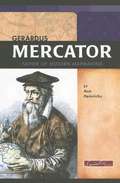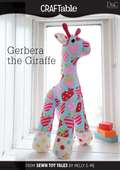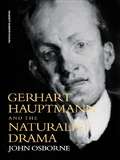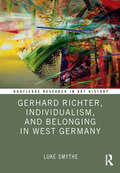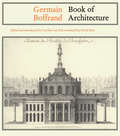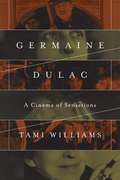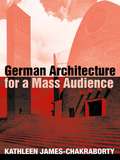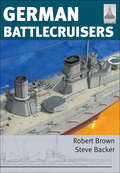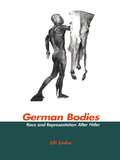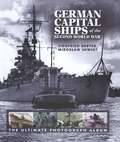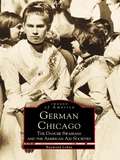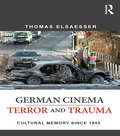- Table View
- List View
Georgia Witness: A Contemporary Oral History of the State
by Stephen DosterDrawing on the voices of residents from across the state, this oral history reflects on life in Georgia as it evolved throughout the twentieth century. Author Stephen Doster grew up on St. Simons Island, one of Georgia&’s Golden Isles. He began interviewing fellow island residents and captured their personal histories in the book Voices from St. Simons. Now, Doster has expanded the scope of his work to encompass the entire state of Georgia. In Georgia Witness, Doster records the stories of residents from all across the state, capturing the unique life and history of its many communities. Here are the voices of influential figures and ordinary residents, individuals of varying backgrounds and ethnicities, all of whom remember and contribute to the legacy and lifeblood of the peach state.
Georgia and Anita: The Lifelong Friendship of Georgia O'Keeffe and Anita Pollitzer
by Liza BennettGeorgia O&’Keeffe knew as soon as she met Anita Pollitzer that they had nothing in common. Anita looked like a china doll, small boned and delicate, and obviously well-to-do in her fashionable tunics and hobble skirts. She had the kind of mouth that settled naturally into a smile, which irritated O&’Keeffe, who had no time for dewy-eyed girls. Yet this first impression was the beginning of a lifelong friendship that had a tremendous impact on both women and on twentieth-century America. In Georgia and Anita Liza Bennett tells the little-known story of their enduring friendship and its ultimately tragic arc. It was Pollitzer who first showed O&’Keeffe&’s work to family friend and mentor Alfred Stieglitz, the world-famous photographer whose 291 Gallery in New York City was the epicenter of the modern art world. While O&’Keeffe, Stieglitz, and their circle of friends were at the forefront of American modernism, Pollitzer became a leader of the National Woman&’s Party and was instrumental in the passage of the Nineteenth Amendment, guaranteeing women the right to vote. Based on extensive research, including their fifty-year correspondence, Georgia and Anita casts light on the friendship of these two women who, in different ways, helped to modernize the world and women&’s roles in it. For more information about Georgia and Anita, visit georgiaandanita.com.
Georgia's Bones
by Jen BryantGrowing up on a Wisconsin farm, Georgia O'Keeffe began gathering all sorts of objects — sticks and stones, flowers and bones. Although she was teased for her interest in unique shapes and sizes, young Georgia declared: “Someday, I’m going to be an artist” — and that is exactly what she became. Jen Bryant’s story of Georgia O’Keeffe celebrates the famous artist’s fascination with natural shapes, “common objects,” and her unusual way of looking at the world. Bethanne Andersen’s fluid, graceful illustrations capture the beauty of O’Keeffe’s work and spirit.
Georgia's Civilian Conservation Corps
by Connie M. HuddlestonAt a time when our country struggled with a deep financial depression, the United States began to see incredible numbers of men and women who could not find work. During the first days of his administration, Pres. Franklin D. Roosevelt sought to create opportunities for this country's uneducated and undereducated young men to find work, help support their families, and receive training in a variety of fields. President Roosevelt's own vision brought about the Civilian Conservation Corps (CCC). Images of America: Georgia's Civilian Conservation Corps examines the role these young men played in developing three national forests, three national monuments, a national battlefield, 10 state parks, and four military installations. This book illustrates and gives voice to the CCC's rich contribution to Georgia's landscape and history and allows us to understand how the creation of this social employment program was once seen as the shining example of FDR's New Deal.
Georgia's Terrific, Colorific Experiment
by Zoe PersicoScience and art come together in this colorful and empowering picture book about a strong minded girl scientist and her artist family. Is it possible for science and art to really mix?Georgia wants to be a scientist, and a great one at that. But in order become a great scientist, she must first create her own, unique experiment. Her mother, father, grandma, and brother all want to help, but they're artists. How could they possibly help her with science? Everyone knows art and science just don't go together!As Georgia struggles to create her unique experiment, she eventually learns that sometimes science, too, can be a work of art.
Georgia: A State History (The\making Of America Ser.)
by Buddy Sullivan Georgia Historical SocietyGeorgia's past has diverged from the nation's and given the state and its people a distinctive culture and character. Some of the best, and the worst, aspects of American and Southern history can be found in the story of what is arguably the most important state in the South. Yet just as clearly Georgia has not always followed the road traveled by the rest of the nation and the region. Explaining the common and divergent paths that make us who we are is one reason the Georgia Historical Society has collaborated with Buddy Sullivan and Arcadia Publishing to produce Georgia: A State History, the first full-length history of the state produced in nearly a generation. Sullivan's lively account draws upon the vast archival and photographic collections of the Georgia Historical Society to trace the development of Georgia's politics, economy, and society and relates the stories of the people, both great and small, who shaped our destiny. This book opens a window on our rich and sometimes tragic past and reveals to all of us the fascinating complexity of what it means to be a Georgian.
Georgian Architectural Designs and Details: The Classic 1757 Stylebook
by Abraham SwanAmong the 18th century's most influential architectural designers and writers, Abraham Swan defined many conventions of English rococo detail. This reprint of an extremely rare and classic stylebook, compiled by the English architect nearly 250 years ago, provides outstanding examples of Palladian and Georgian architecture and design in colonial America and England.Included are floor plans, detailed elevations, and drawings for cornices, mouldings, and other decorative elements that demonstrate Swan's unique style. Designed, in his words, more for "Gentlemen of moderate Fortunes than of great Estates who may be inclined to build Houses," Swan's designs featured such aesthetic touches as double staircases, elegant entryways, and two or three floors with spacious galleries, salons, and dressing rooms.Invaluable to architectural historians and designers, this splendid stylebook will delight devotees of early English Georgian and American domestic architecture and interior design, cultural historians, artists, and craftworkers.
Georgian Houses for All (Routledge Revivals)
by John WoodfordeFirst published in 1978, Georgian Houses for All describes how little Gregorian houses came into being and how the original inhabitants used them. Gregorian houses at their smallest and simplest can be seen everywhere in the British Isles – detached, semi-detached and joined together in terraces. There are probably still over a million of them, built during a period of 130 years without the direct aid of architects. John Woodforde points out that an instinctive wish for a symmetrical front seems to be shown by young children’s drawings of houses, these being generally balanced and orderly. The Georgians’ love of symmetry, marked in their way of hanging pictures, was part of a desire for private order amongst public disorder, a desire to have one small sphere in which nature was fully controlled. John Woodforde reminds us that, in the present-day return to terrace-house building, the Georgian version remains a valuable guide. The book will be of interest to students of architecture, urban planning, and history.
Geospatial Analysis and Modelling of Urban Structure and Dynamics
by Bin Jiang Xiaobai YaoThe increasingly urbanized world has created various problems of environment, climate, consumption of resources, and public health, which are closely linked to the side-effects of urbanization such as sprawl, congestion, housing affordability and loss of open space. Fundamental to the urban problems are two separate yet related issues: urban structure and urban dynamics. The chapters collected in this book present an excellent profile of the current state of geospatial analysis and modelling, and demonstrate how these approaches can contribute to the study of various urban issues. The book addresses key themes including new ways of capturing data digitally at the individual level, the development of systems based around networks, the notion of linking hierarchy to networks to morphology as in complexity theory, and the development of new ways of integrating diverse urban processes through simulation paying careful attention to the basic econometric and statistical principles of spatial analysis. With a foreword by Michael Batty and an epilog by Michael F. Goodchild.
Geotechnical Centrifuge Technology
by R. N. TaylorThis book provides a thorough review of this powerful and sophisticated technique for modelling soil structure interactions. It has been written by an international team of authors.
Geotechnical Engineering for the Preservation of Monuments and Historic Sites III: Invited papers
by Renato LancellottaThis book contains the invited lectures presented at the 3th International Symposium on Geotechnical Engineering for the Preservation of Monuments and Historic Sites (IS NAPOLI 2022, Naples, Italy, 22-24 June 2022). It collects the opening address, the third Kerisel Lecture, four keynote lectures and eleven panel lectures, and provides a broad impression of 1. the current state of knowledge and 2. the techniques used worldwide for the preservation of built heritage. When confronted with structures relevant to local and global history, there is only one way to select the best possible conservation solution: the multidisciplinary approach. Therefore, the invited speakers have been selected with different pertinent skills, to represent this complexity from the points of view of geotechnical engineers, structural engineers, architects and conservation experts. The book will be useful to researchers, practitioners, administrations and all those working or interested in the preservation of built heritage.
Gerardus Mercator: Father of Modern Mapmaking
by Ann HeinrichsMercator was destined to be one of the most famous mapmakers in history. Before his time, many maps were as much about myths as geographical reality, filled with exotic creatures and fabled lands. But he turned cartography, or map-making, into a science. He based his maps on firsthand reports, using mathematical calculations whenever possible to pinpoint locations.
Gerbera the Giraffe
by Me MellyCats are well known for their curiosity, but giraffes? This pretty, prancing giraffe certainly has an inquisitive side to her nature, although she can be a bit jumpy and bound off if things go horribly wrong as a consequence of her investigations. Simple gathering is used to good effect here in creating Gerbera's frilly mane and attractively shaped ears. She may be spotted like her wild cousins, but her cover is easily blown with her coat of a heady mix of bright colours and patterns.
Gerhard Hauptmann and the Naturalist Drama
by John OsborneWhat was German Naturalism? What were its achievements? How does it compare with its counterparts in other European countries? These are some of the difficult questions addressed by John Osborne in Gerhart Hauptmann and the Naturalist Drama, a revised and updated version of his The Naturalist Drama in Germany, now widely acknowledged as the standard introduction to the subject. The debates to which he contributed, and in some cases initiated, on Naturalism in the German theatre, Naturalist theory in Germany, and the development of the Naturalist movement to the contemporary Social Democrat movement, have remained central issues. This revised edition preserves the structure and approach of the original, including its emphasis on the early dramas of Hauptmann, while taking full account of subsequent scholarship which provides the context in which this Naturalist playwright's work can be placed.
Gerhard Richter, Individualism, and Belonging in West Germany (Routledge Research in Art History)
by Luke SmytheThis book reevaluates the art of Gerhard Richter (b. 1932) in relation to his efforts to achieve belonging in the face of West Germany’s increasing individualism between the 1960s and the 1990s. Richter fled East Germany in 1961 to escape the constraints of socialist collectivism. His varied and extensive output in the West attests to his greater freedom under capitalism, but also to his struggles with belonging in a highly individualised society, a problem he was far from alone in facing. The dynamic of increasing individualism has been closely examined by sociologists, but has yet to be employed as a framework for understanding broader trends in recent German art history. Rather than critique this development from a socialist perspective or experiment with new communal structures like a number of his colleagues, Richter sought and found security in traditional modes of bourgeois collectivity, like the family, religion, painting and the democratic capitalist state. The book will be of interest to scholars working in art history as well as German history, culture and politics.
Gerhard Richter: A Life In Painting
by Dietmar Elger Elizabeth M. SolaroThis fascinating book offers unprecedented insight into artist Gerhard Richter's life and work. From his childhood in Nazi Germany to his time in the West during the turbulent 1960s and '70s, this work presents a complete portrait of the often-reclusive Richter.
Germain Boffrand: Book of Architecture Containing the General Principles of the Art and the Plans, Elevations and Sections of some of the Edifices Built in France and in Foreign Countries
by Caroline van EckThis title was first published in 2003. Germain Boffrand was one of the great French architects of the early eighteenth century. His work encompassed not only the design of town and country houses for the wealthy but also mines, bridges and hospitals. His Livre d’Architecture is one of the most original books on architecture ever written in France. Taking the Art of Poetry by the Latin poet Horace as its starting point, it developed an aesthetic of architecture focused on character, style and the emotional impact of a building that influenced Blondel, Le Camus de Mezieres and Soane, and is still central to contemporary debate about the nature and meaning of architecture. Translated for the first time by David Britt, Boffrand’s text is here accompanied by an extensive introduction and notes by Caroline van Eck who situates Boffrand within the main issues of eighteenth-century architectural aesthetics. Beautifully illustrated, including all the pictures chosen by Boffrand for his original publication, this book is an invaluable tool for teaching the history of architectural theory and an essential work for any architectural library. Germain Boffrand is published with the assistance of the Getty Foundation.
Germaine Dulac: A Cinema of Sensations
by Tami WilliamsBest known for directing the Impressionist classic The Smiling Madame Beudet and the first Surrealist film The Seashell and the Clergyman, Germaine Dulac, feminist and pioneer of 1920s French avant-garde cinema, made close to thirty fiction films as well as numerous documentaries and newsreels. Through her filmmaking, writing, and cine-club activism, Dulac's passionate defense of the cinema as a lyrical art and social practice had a major influence on twentieth century film history and theory. In Germaine Dulac: A Cinema of Sensations, Tami Williams makes unprecedented use of the filmmaker's personal papers, production files, and archival film prints to produce the first full-length historical study and critical biography of Dulac. Williams's analysis explores the artistic and sociopolitical currents that shaped Dulac's approach to cinema while interrogating the ground breaking techniques and strategies she used to critique conservative notions of gender and sexuality. Moving beyond the director's work of the 1920s, Williams examines Dulac's largely ignored 1930s documentaries and newsreels establishing clear links with the more experimental impressionist and abstract works of her early period. This vivid portrait will be of interest to general readers, as well as to scholars of cinema and visual culture, performance, French history, women's studies, queer cinema, in addition to studies of narrative avant-garde, experimental, and documentary film history and theory.
German Architecture for a Mass Audience
by Kathleen James-ChakrabortyThis book vividly illustrates the ways in which buildings designed by many of Germany's most celebrated twentieth century architects were embedded in widely held beliefs about the power of architecture to influence society. German Architecture for a Mass Audience also demonstrates the way in which these modernist ideas have been challenged and transformed, most recently in the rebuilding of central Berlin.
German Battlecruisers (ShipCraft #22)
by Robert Brown Steve BackerThe 'ShipCraft' series provides in-depth information about building and modifying model kits of famous warship types. Lavishly illustrated, each book takes the modeller through a brief history of the subject class, highlighting differences between sisterships and changes in their appearance over their careers. This includes paint schemes and camouflage, featuring colour profiles and highly-detailed line drawings and scale plans. The modelling section reviews the strengths and weaknesses of available kits, lists commercial accessory sets for super-detailing of the ships, and provides hints on modifying and improving the basic kit. This is followed by an extensive photographic survey of selected high-quality models in a variety of scales, and the book concludes with a section on research references—books, monographs, large-scale plans and relevant websites.This volume is devoted to the famous ships of Admiral Hipper's First Scouting Group. Slower but more robust than their British equivalents, German battlecruisers enjoyed a reputation for absorbing punishment, and although Lutzow was sunk at Jutland, Seydlitz and the rest of the Scouting Group survived heavy damage. This book concentrates on the seven completed ships but coverage extends to the 'proto-battlecruiser' Blucher and the ships building or designed by the end of the war.
German Bodies: Race and Representation After Hitler
by Uli LinkeFirst published in 1999. Routledge is an imprint of Taylor & Francis, an informa company.
German Capital Ships of the Second World War: The Ultimate Photograph Album
by Miroslaw Skwiot Siegfried Breyer&“Outstanding . . . covers the major units starting with the Deutschland Class, through the Scharnhorst and Gneisenau, to the Bismarck and Tirpitz.&” —WW2 Cruisers The Kriegsmarine&’s capital ships—Deutschland, Admiral Scheer, Graf Spee, Scharnhorst, Gneisenau, Bismarck, and Tirpitz—continue to generate intense interest among warship enthusiasts, despite the fact that no new source of information has been unearthed in decades. What has come to light, however, is a growing number of photographs, many from private albums and some that lay forgotten in obscure archives. These include many close-ups and onboard shots of great value to modelmakers, as well as rare action photos taken during wartime operations. This book is a careful selection of the best of these, but on a grand scale, with around one hundred images devoted to each ship, allowing in-depth coverage of its whole career, from launching and fitting out to whatever fate the war had waiting for it. For sake of completeness, there are even sections reproducing the various design studies that led to each class, while an appendix covers the uncompleted Graf Zeppelin, Germany&’s only attempt to build an aircraft carrier, the vessel which clearly displaced the battleship as the capital ship of the world&’s navies during the war. Essays on technical backgrounds and design origins by the well-known expert Siegfried Breyer and explanatory captions by Miroslaw Skwiot draw out the full significance of this magnificent collection of photos. &“Highly recommended for those who wish to admire seven of the most magnificent warships built anywhere in the twentieth century. We will certainly never see their like again.&” —Journal of the Australian Naval Institute
German Chicago: Revisited (Images of America)
by Raymond LohneGerman Chicago Revisited follows the photographic study which began in German Chicago: The Danube Swabians and the American Aid Societies. With this latest title in the Images of America series, historian and photographer Raymond Lohne crafts another volume about a group of American citizens who preserve their rich heritage with unwavering effort.This book will give readers a glimpse into the life of a close-knit and highly active community, revealing groups like the Kerneir Pleasure Club, the American Aid Society, and the Society of the Danube Swabians. The German musical life of the city is featured, as is the Karneval season and other year-round festivities and celebrations of the Deutsch-Americans of Chicago and its suburbs.
German Chicago: The Danube Swabians and the American Aid Societies
by Raymond LohneIn German Chicago: The Danube Swabians and the American Aid Societies, historian Raymond Lohne presents the Germans who came to be called the Donauschwaben and their American counterparts. This amazing photographic collection of over 200 historic images has been gathered through the efforts of the author and survivors of the Expulsion, as well as numerous German-American societies and individuals throughout the nation.
German Cinema - Terror and Trauma: Cultural Memory Since 1945
by Thomas ElsaesserIn German Cinema – Terror and Trauma Since 1945, Thomas Elsaesser reevaluates the meaning of the Holocaust for postwar German films and culture, while offering a reconsideration of trauma theory today. Elsaesser argues that Germany's attempts at "mastering the past" can be seen as both a failure and an achievement, making it appropriate to speak of an ongoing 'guilt management' that includes not only Germany, but Europe as a whole. In a series of case studies, which consider the work of Konrad Wolf, Alexander Kluge, Rainer Werner Fassbinder, Herbert Achterbusch and Harun Farocki, as well as films made in the new century, Elsaesser tracks the different ways the Holocaust is present in German cinema from the 1950s onwards, even when it is absent, or referenced in oblique and hyperbolic ways. Its most emphatically "absent presence" might turn out to be the compulsive afterlife of the Red Army Faction, whose acts of terror in the 1970s were a response to—as well as a reminder of—Nazism’s hold on the national imaginary. Since the end of the Cold War and 9/11, the terms of the debate around terror and trauma have shifted also in Germany, where generational memory now distributes the roles of historical agency and accountability differently. Against the background of universalized victimhood, a cinema of commemoration has, if anything, confirmed the violence that the past continues to exert on the present, in the form of missed encounters, retroactive incidents, unintended slippages and uncanny parallels, which Elsaesser—reviving the full meaning of Freud’s Fehlleistung—calls the parapractic performativity of cultural memory.
